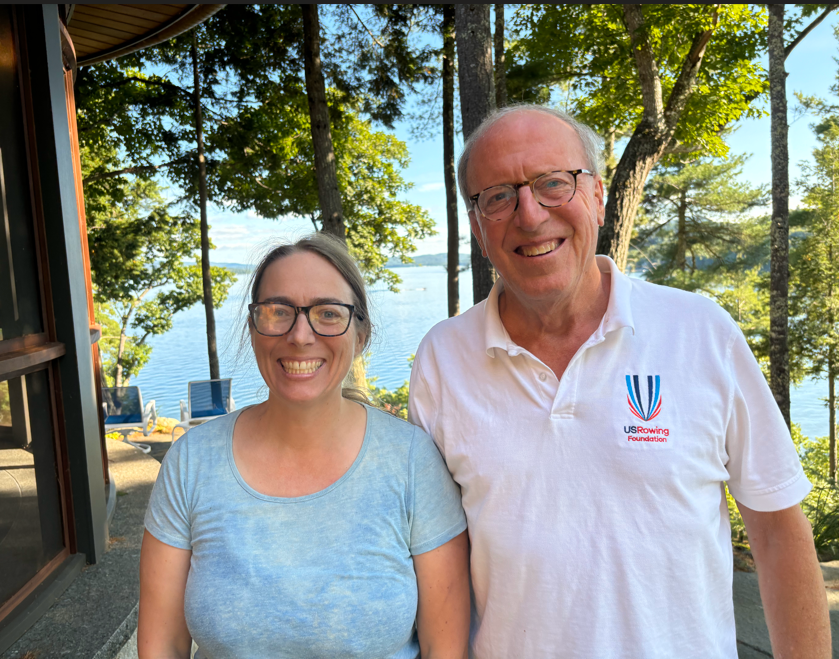By PAULA TRACY, InDepthNH.org
HEBRON – Big Squam, Lake Sunapee, Lake Winnipesaukee, Newfound, Lake Wentworth.
New Hampshire boasts some of the cleanest, clearest lakes in the world from various reports and points of view, none of which is verifiable or certifiable.
But one Newfound Lake resident believes this is the clearest of them all, if 2022 statistics are applied.
While Andy McLane admits he is no scientist. He lives with his wife Linda in a house with a commanding view of Newfound and likes to collect data. When he looked at 2022 data and when measurements for clarity from dropped secchi disks into the lake are also added, Newfound Lake ranks at the very tippy top of the list.
He went over some of his data with Rebecca Hanson, executive director of the Newfound Lake Region Association. She said there is no empirical winner in this competition, but it is interesting to see how some of the biggest lakes in the state match up in terms of measurements of color, chlorophyll and phosphorus.
“It’s a healthy competition…especially here in Newfound I think folks like to really feel that we are such a clean lake here,” said Hanson, regardless of the fact there is no one lake, which is the “fairest in the land.”
The year 2023 was a bad one for data and not typical for varying reasons, both Hanson and McLane said but using 2022 collected data for the secchi disk observances, the disk can be seen in 8.8 feet of water on Newfound Lake where Winnipesaukee comes in next with 8.4 feet, Sunapee at 8 feet, Lake Wentworth at 7.2 feet and Big Squam at 6.6 feet.
The other metrics McLane lists, and Hanson noted, are the lowest numbers for content of chlorophyll and phosphorus which are best.
Content of phosphorus measured in parts per million on Newfound was 1.5 ppm, tied with Little Squam for the lowest at 1.5 ppm as well. Winnipesaukee and Wentworth were a close second with 1.6 ppm and Big Squam was at 2.0 ppm and Sunapee at 2.5 ppm.
Phosphorus, also in ppm found Newfound with 4 ppm, Winnipesaukee with 5.8, Little Squam with 5.9, Sunapee at 6 ppm and Big Squam at 7.4 ppm.
For color, Little Squam scored lowest and best at 7.9 ppm, Winnipesaukee next at 8.5 ppm, Newfound was third at 10 ppm, Big Squam was 10.4 ppm and Wentworth was 13.9 ppm
“This started a few weeks ago. I sent out an email a few weeks ago,” to fellow lake observers and they looked at the largest lakes in the state, but Umbagog was not considered because 40 percent of it is in Maine and the average depth is 10 feet making it more like a pond despite its acreage.
Winnipesaukee has 288 miles of shoreline. Squam 65, Newfound, 22 miles.
Newfound’s depth average is 74 feet deep and
has some of the deepest spots of any lake in the state.
Tests sites are usually at the deepest spots on each lake, Hanson said.
There is a misnomer that Newfound is primarily spring fed when only 6 percent of the lake water comes from springs, Hanson said.
“The springs on Newfound is such a myth, here and I like to bust that myth,” Hanson said.
While Squam Lake has mostly small tributaries, you can walk over, with the exception of Owl Brook which floats out of Little Squam in its river and enters the Pemigewasset River.
Newfound has both the Cockermouth and the Fowler River which feed into the lake and those rivers are largely undeveloped and less steep than some other lake watersheds on the list.
All the lakes on the list have sustainable watershed management plans with the exception of some bays on Winnipesaukee which are currently being done, thanks to federal funding the federal Clean Water Act Section 319 which is paying for the important plans, Hanson said.
“We are still benefiting from the Clean Water Act,” of 1972 which helped fund sewer systems and treatment plans including the one on the Merrimack River which treats water from many Lakes Region communities.
The management plans identify problem areas where storm runoff enters the lake allowing for remediation targets which would reduce phosphorus, which is a key driver for lake problems like cyanobacteria and turbidity.
Newfound has never had a reported case of cyanobacteria, while Winnipesaukee has a number of watches or warnings issued for cyanobacteria.
Squam had its last case of cyanobacteria in 2018 and is free of the blue green algae as well. It has a management plan which Hanson drafted while working there at the Squam Lakes Association for eight years.
Hanson said Section 319 funds also help various lake associations hire planning consultants to work with local planning boards on regulations in each town.
McLane said, “everybody cares,” to keep the statistics high and Hanson said, “stormwater management and land protection, protecting our forested hillsides,” are the most important things to do to protect the lakes.
“We want that water to infiltrate and not flow across the landscape picking up nutrients, pollutants and things like that” she said. “So protecting land so it doesn’t get developed and then protecting land that is already developed by managing the storm flow on the property.”
McLane said he wants people who live within the watershed of the lake, not necessarily lakefront property owners, to think about their importance and role in keeping water quality high.
“The source of the cleanliness of the lake is dependent on where the water comes from,” McLane said.
He said lake lovers should go out into the middle of the lake and look at the high points from all around it and note that is where the water comes from to that point and that all who are within that area have a role to play in who’s lake is the fairest of them all.





